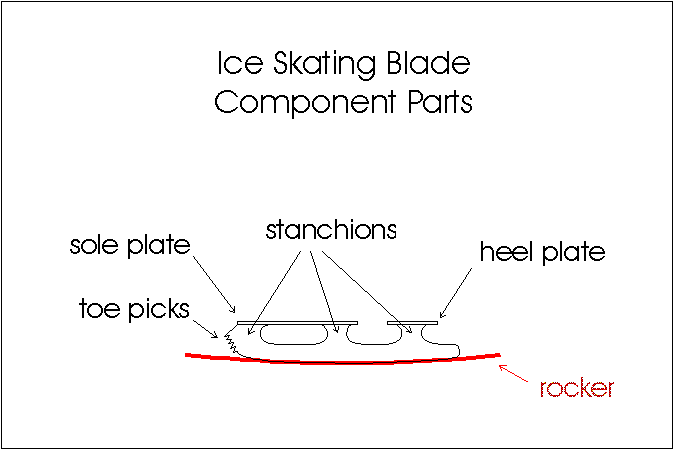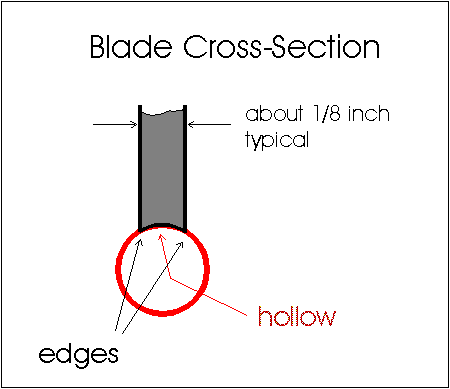
There are many models of boots and blades available to the skater. The blade and boot combination that is right for a given skater depends on many factors, and the choice is not a simple one.
Boot design is a compromise between the need for firm support of the ankle to allow the skater to stand up on their blades, and the need for enough mobility of the ankle to permit control of the edges and the distribution of weight along the length of the blades.
The structure of the human ankle is such that it is virtually impossible for an individual to stand on a pair of blades with an unsupported ankle for any significant length of time. The feet will invariably rotate to the inside or the outside in short order. The main purpose of boots then, is to support the ankles. Skaters who cannot stand up on their blades do not have weak ankles, they have lousy boots. A good pair of boots allows only a small amount of rotation of the foot to the inside or outside, generally enough only to get on an edge. For the most part, however, skaters get on an edge through lean and not rotation of the foot.
To a lesser extent boots also restrict the lean of the skater towards the toe or over the heel. It is feasible to design a pair of boots that restrict rotation of the foot to the inside or outside, but still allow total mobility in pointing the toe. This also, however, is not desirable. Boots are designed to provide enough mobility to get onto the heel or toe when needed, and still maintain stability and support of the foot.
Boots are constructed with a stiff piece of leather at the back of the heel, called the counter, and two or three layers of leather in the body of the boot. Different models of boots have different degrees of stiffness, and thus different amounts of support and flexibility. The stiffness of a boot not only affects the mobility of the foot, but also the durability of the boot. Over time, as the boot leather flexes, stiffness decreases. This decreases support of the ankle, and increases mobility of the foot. When the boot no longer provides the support the skater desires, and allows too much freedom of motion, the boot is said to be "broken down". At this point its time for a new pair of boots. How long this takes depends on the quality of the boot, the frequency with which it is used, and the size and ability of the skater. For a cheap pair of boots this might take place in only a few months. For a quality pair of boots it might take a few years.
In fitting a pair of boots, the heels of the feet should be held snugly but not tightly in place. They should not have room to flop around in, but also, should not be held tightly enough to cause discomfort, or to rub and cause blisters. The arch supports should be properly positioned and have the right shape to support the arches without discomfort. Boots should be wide enough, and have enough room in the toe to allow the toes and balls of the feet to move around comfortably.
Various models of boots differ not only in their stiffness, but also in the design of the arch supports, and room for the balls of the feet and toes. Certain models favor skaters with wide feet, others with narrow. Skaters who cannot find stock boots (off the shelf boots) that comfortably fit their feet usually turn to custom made boots built specifically for the shapes of their feet (the left and right feet are not identical in either size and shape for most people). Custom boots cost about twice as much as top of the line stock boots.
Another way that various boot models differ is in the height of the heel. The height of the heel combined with the shape of the blade determine the location of the balance point for the skate. In general, European boots have slightly higher heels than American boots.
New boots should be waterproofed, and the heels and soles sealed before they are used. This should be done before the blades are mounted to protect the leather under the heel and sole plates where moisture can accumulate. The most common method of sealing the heels and soles is to coat them with heel and sole enamel or with shellac. This offers only temporary protection since enamel and shellac will crack over time. Water can seep through these cracks into the leather, leading to its deterioration. Consequently heels and soles have to be retreated periodically.
A better method of sealing heels and soles is to use a hot wax treatment that penetrates the leather, fills its pores, and prevents water from being absorbed. Boots that have been enameled or shellacked can only be treated with hot wax after they have been thoroughly cleaned to remove the previous coating.
After each day of use, boots should be allowed to dry at room temperature in a well ventilated area, not in an equipment bag or closet. Drying boots with a towel alone is not sufficient.
When left in an unventilated area, or worse yet in the back of a hot car or trunk, wet boots dry out too slowly, accelerating decay of the leather. In tropical Florida, for example, wet boots cooked in the back of a hot car have been known after many months of this abuse to deteriorate slowly into a black tarry sludge as the leather is consumed by hungry bacteria snacking on the oh so yummy leather.
Repeated soaking and drying also causes the oils in leather to wash out. This leads to a loss of flexibility, and eventually to cracking. To prevent this, leather should be treated with a conditioner and preservative such as Lexol. In addition, a source of heat should not be used to speed up drying of wet boots. This too can lead to premature loss of leather flexibility and cracking. Similarly, storing dry boots in the back of a hot car, trunk, or similar environment for extended periods of time should also be avoided.

Blades are always mounted with the front tips of the sole plates lined up with the front edges of the soles of the boots. When the blades are mounted behind or ahead of the front edges of the soles of the boots, the balance points will be incorrectly located, and the range of motion needed to get onto the toe picks will be too small, or too great, .
Blade size must be matched to the boots they are mounted on. Blades are the correct size when the length from the front of the sole plates to the rear of the heel plates is about 1/4 to 1/3 inch less than the distance from the front of the soles to the rear of the heels of the boots. This results in the heel plates being correctly located under the heels of the feet. Some European boots have strongly tapered heels, requiring the use of slightly longer blades which reach near the back edge of the heels. To insure a proper fit, John Wilson blades are sold in 1/4 inch length increments, while MK blades are sold in 1/3 inch increments.
Some latitude in blade size is acceptable. Blades up to 1/2 inch shorter than the boots they are mounted on will have only a minor decrease in stability when leaning back over the heels. Blades somewhat longer than the norm may be used with a corresponding small increase in rearward stability, but with a greater chance for the skater to accidentally step on the ends of the blades and go flying. Blades substantially longer or shorter than the nominal length, however, should not be used. Some parents occasionally choose to purchase blades one size larger than nominal (1/4 or 1/3 inch) when they have a growing child who will soon be moving up to larger boots. This is an acceptable practice so long as the heel plates do not substantially overhang the ends of the heels of the skater's current boots (no more than about 1/16 inch).
There are many models of blades to choose from. Blades vary in length, shape, thickness, and design of the toe picks. The sides of the blades may be parallel, sloped, or concave. Some models are uniformly thick, others are tapered along their length.
 New blades come ground with the
average hollow appropriate for their design. The hollow is specified by the radius of the
circular contour ground into the blade; typically 0.5 to 1.0 inches for freestyle blades.
The shorter the radius, the deeper the hollow, and the more firmly the blades grip the
ice.
New blades come ground with the
average hollow appropriate for their design. The hollow is specified by the radius of the
circular contour ground into the blade; typically 0.5 to 1.0 inches for freestyle blades.
The shorter the radius, the deeper the hollow, and the more firmly the blades grip the
ice.
The smooth curve of the blade from front to rear is called the rocker. For patch blades the rocker is an arc of a circle over most of its length, with the rocker becoming more curved closer to the toe picks. The rocker of a freestyle blade is an arc of a circle over its center section, becoming more curved closer to both the toe picks and the rear of the blade. The rocker is specified by the length of the radius of the circle whose arc makes up most of the rocker. This radius can be as little as 6.5 feet and as long as 10 feet. For various blades having the same length, the blades with the shorter rocker radius are more maneuverable (easier turns and loops) but slower running, and have lower stability. Blades with a longer rocker radius are less maneuverable, faster running, and steadier.
The shape of the blades in the toe area, and the shape of the toe picks controls the ease with which the skater can get up onto the toe picks. Some models require greater ankle and knee flexion to get onto the toe picks, others less. This affects the action of the blades in spins and jumps.
Most blades are uniformly thick along their length, but some are tapered towards the heel. Blade manufactures claim that a tapered blade is faster running, and is better for turns than a blade of uniform thickness.
Some blade manufacturers also claim that blades whose sides are concave or tapered towards the edges allow the skater to get on the edges faster. There is, however, no evidence for this. Thus, this aspect of blade design should not be made a deciding factor when choosing blades, except as follows. It is far more difficult to correctly sharpen a concave or side tapered blade than a parallel sided blade. Consequently, non-parallel sided blades end up being incorrectly sharpened more often than parallel sided blades.